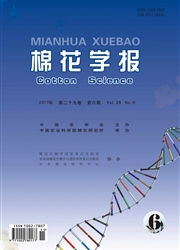

 中文摘要:
中文摘要:
运用空间统计学的模拟方法,以不同密度棉花群体为研究对象,对其冠层内光合有效辐射(PAR)的空间分布予以研究。通过拟合PAR透射率的半方差函数模型和绘制等值线图来反映不同密度群体冠层内PAR透射率的空间格局。利用克里格空间内插法和Sirnpson3/8法计算出盛蕾期棉花群体平均PAR透射率,分析其与LAI的回归关系,并对克里格插值法进行交叉验证。结果表明,冠层PAR存在强烈的空间自相关性,变异函数的最佳理论模型为高斯模型,决定系数均在0.9以上。各密度冠层PAR透射率具有相似的空间格局,但其变异程度有随密度增加而上升的趋势。群体平均PAR透射率与叶面积指数(LAI)呈指数回归关系,与前人研究结果一致。应用空间计学研究PAR空间分布格局,将有助于对PAR进行精确定位和定量化地估算,为怍物科学配置和作物冠层结构调控提供理论依据。
 英文摘要:
英文摘要:
A spatial statistics simulation method was applied to study the spatial distribution of photosynthetically active radiation (PAR) within cotton canopy grown at different densities. Spatial pattern of PAR transmittance rate was reflected depending on the semivariograms and contour maps. The average PAR transmittance rate was calculated using the Kriging interpolation and the Simpson3/8 rule. The regression analysis was used to explore the correlation between average PAR transmittance rate and leaf area index (LAI). Cross validation was used to evaluate the predict accuracy of PAR transmittance rate by the Kriging inter- polation. The results showed that PAR transmittance rate had strong spatial autocorrelation that perfectly fitted the Gaussian semivariogram model. The coefficients of determination were above 0.9 in all treatments. There were similar spatial patterns of PAR transmittance rate among different plant densities, but variance degree increased with increased plant density. There was an exponential correlation between average PAR transmittance rate of the canopy and leaf area index, which was consistent with previous studies. Applying spatial statistics to study the spatial distribution pattern of PAR will help to estimate PAR accurately. It will also be useful for optimizing co-cultivation methods and adjustment of crop canopy.
 同期刊论文项目
同期刊论文项目
 同项目期刊论文
同项目期刊论文
 期刊信息
期刊信息
